Tea Tree Oil
The Many Uses of Tea Tree Oil
 Scientific Name: {Melaleuca alternifolia}
Scientific Name: {Melaleuca alternifolia}
Common Name: {Melaleuca oil, tea tree leaf oil}
Often touted as a miracle ingredient, tea tree oil is full of incredible skin benefits. It derives from trees grown almost exclusively in Asia and Australia.
For centuries, tea tree oil has been used by native populations for both medicinal and cosmetic purposes, ranging from antiseptics that treat cuts and scrapes to lotions for burns and irritated skin.
One of the most popular stories about discovering tea tree’s skin benefits comes from Australia. The legend says hundreds of tea trees surrounded a pond. The leaves fell into the water and gave the pool healing properties.
You no longer have to travel to Australia to sit in a pool to reap the benefits of this oil. Instead, the oil is extracted and sent worldwide for use in cosmetics and natural medicines.
Skin Benefits
With all of the hype surrounding tea tree oil, what are the real benefits?

- Some studies have suggested that tea tree oil is just as effective, if not more effective, than benzoyl peroxide when dealing with problematic skin. It lacks the side effects that make many stay away from benzoyl peroxide. In addition,this oil can naturally keep the skin healthy. It does not irritate the skin, make it red, nor cause it to peel like other acne treatments do; ideal if you have both acne and sensitive skin that reacts badly to the introduction of harsh chemicals.
- Because it is antiviral, antibiotic, and anti-fungal, it is one of the best natural substances for cuts, scraps, and even underlying photo-aging. In addition, it works overtime to soften skin and provide the nutrients it needs to renew itself while extending the life of healthy cells so that the skin can retain its youthful appearance.
- If you have sensitive skin or even an occasional bad reaction to a makeup or cleansing product, you know how irritating, inflamed skin can be. Tea tree oil can reduce that inflammation, not just lessen the redness. Additionally, it stems the inflammation at its root so that the skin can regenerate naturally.
About the Author
Kari Thomas wrote this article.


 Buy with Prime
Buy with Prime

